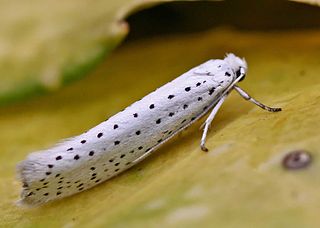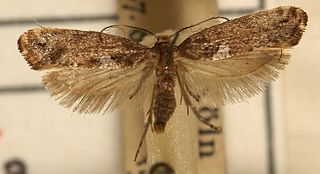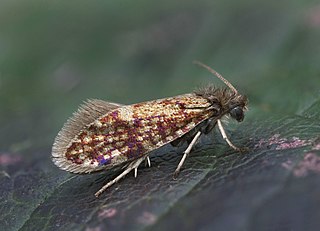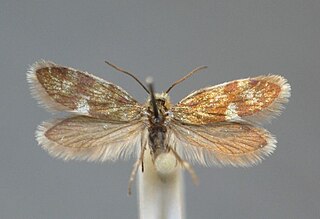
The peppered moth is a temperate species of night-flying moth. It is mostly found in the northern hemisphere in places like Asia, Europe and North America. Peppered moth evolution is an example of population genetics and natural selection.

The luna moth, also called the American moon moth, is a Nearctic moth in the family Saturniidae, subfamily Saturniinae, a group commonly named the giant silk moths.

The family Yponomeutidae are known as the ermine moths, with several hundred species, most of them in the tropics. The larvae tend to form communal webs, and some are minor pests in agriculture, forestry, and horticulture. Adult moths are minor pollinators.

The geometer moths are moths belonging to the family Geometridae of the insect order Lepidoptera, the moths and butterflies. Their scientific name derives from the Ancient Greek geo γεω, and metron μέτρον "measure" in reference to the way their larvae, or inchworms, appear to measure the earth as they move along in a looping fashion. Geometridae is a very large family, containing around 23,000 described species; over 1400 species from six subfamilies are indigenous to North America alone. A well-known member is the peppered moth, Biston betularia, which has been the subject of numerous studies in population genetics. Several other geometer moths are notorious pests.

The de Havilland Gipsy Major or Gipsy IIIA is a four-cylinder, air-cooled, inverted inline engine used in a variety of light aircraft produced in the 1930s, including the famous Tiger Moth biplane. Many Gipsy Major engines still power vintage aircraft types.

The Acrolepiidae are a family of moths known as false diamondback moths. In modern classifications, they are often treated as a subfamily (Acrolepiinae) of the family Glyphipterigidae.

Pterophorus pentadactyla, commonly known as the white plume moth, is a moth in the family Pterophoridae. It is found in the West Palearctic including North Africa and Europe. The wingspan is 26–34 mm (1.0–1.3 in). It is uniformly white, with the hind wing pair divided in three feathery plumes and the front pair in another two. The moths fly from June to August. The larvae feed on bindweed.

Nepticulidae is a family of very small moths with a worldwide distribution. They are characterised by eyecaps over the eyes. These pigmy moths or midget moths, as they are commonly known, include the smallest of all living moths, with a wingspan that can be as little as 3 mm in the case of the European pigmy sorrel moth, but more usually 3.5–10 mm. The wings of adult moths are narrow and lanceolate, sometimes with metallic markings, and with the venation very simplified compared to most other moths.

The de Havilland Gipsy is a British air-cooled four-cylinder in-line aircraft engine designed by Frank Halford in 1927 to replace the ADC Cirrus in the de Havilland DH.60 Moth light biplane. Initially developed as an upright 5 litre capacity engine, later versions were designed to run inverted with increased capacity and power.

Abraxas sylvata, the clouded magpie, is a Palearctic moth of the family Geometridae that was named by Giovanni Antonio Scopoli in 1763.

Rhodometra sacraria, the vestal, is a moth of the family Geometridae. The species was first described by Carl Linnaeus in his 1767 12th edition of Systema Naturae.

Cydia nigricana, the pea moth, is a moth of the family Tortricidae. It is found in Europe.

Spoladea recurvalis, the beet webworm moth or Hawaiian beet webworm moth, is a species of moth of the family Crambidae. It is found worldwide, but mainly in the tropics.
Friedlanderia is a genus of moths of the family Crambidae.

Eriocrania cicatricella is a moth of the family Eriocraniidae found in Europe. It was first described by Johan Wilhelm Zetterstedt in 1839. The larvae mine the leaves of birch.

Eriocrania chrysolepidella is a moth of the family Eriocraniidae found in Europe. It was first described by the German entomologist, Philipp Christoph Zeller in 1851. The larvae mine the leaves of hazel and hornbeam.

Eriocrania is a Palearctic genus of moth of the family Eriocraniidae. The moths are diurnal, flying in sunshine, and the larvae are leaf miners, forming blotches in leaves.

The Erebidae are a family of moths in the superfamily Noctuoidea. The family is among the largest families of moths by species count and contains a wide variety of well-known macromoth groups. The family includes the underwings (Catocala); litter moths (Herminiinae); tiger, lichen, and wasp moths (Arctiinae); tussock moths (Lymantriinae), including the arctic woolly bear moth ; fruit-piercing moths ; micronoctuoid moths (Micronoctuini); snout moths (Hypeninae); and zales, though many of these common names can also refer to moths outside the Erebidae. Some of the erebid moths are called owlets.
Friedlanderia phaeochorda is a moth in the family Crambidae. It was described by Turner in 1911. It is found in Australia, where it has been recorded from Western Australia and the Northern Territory.

















